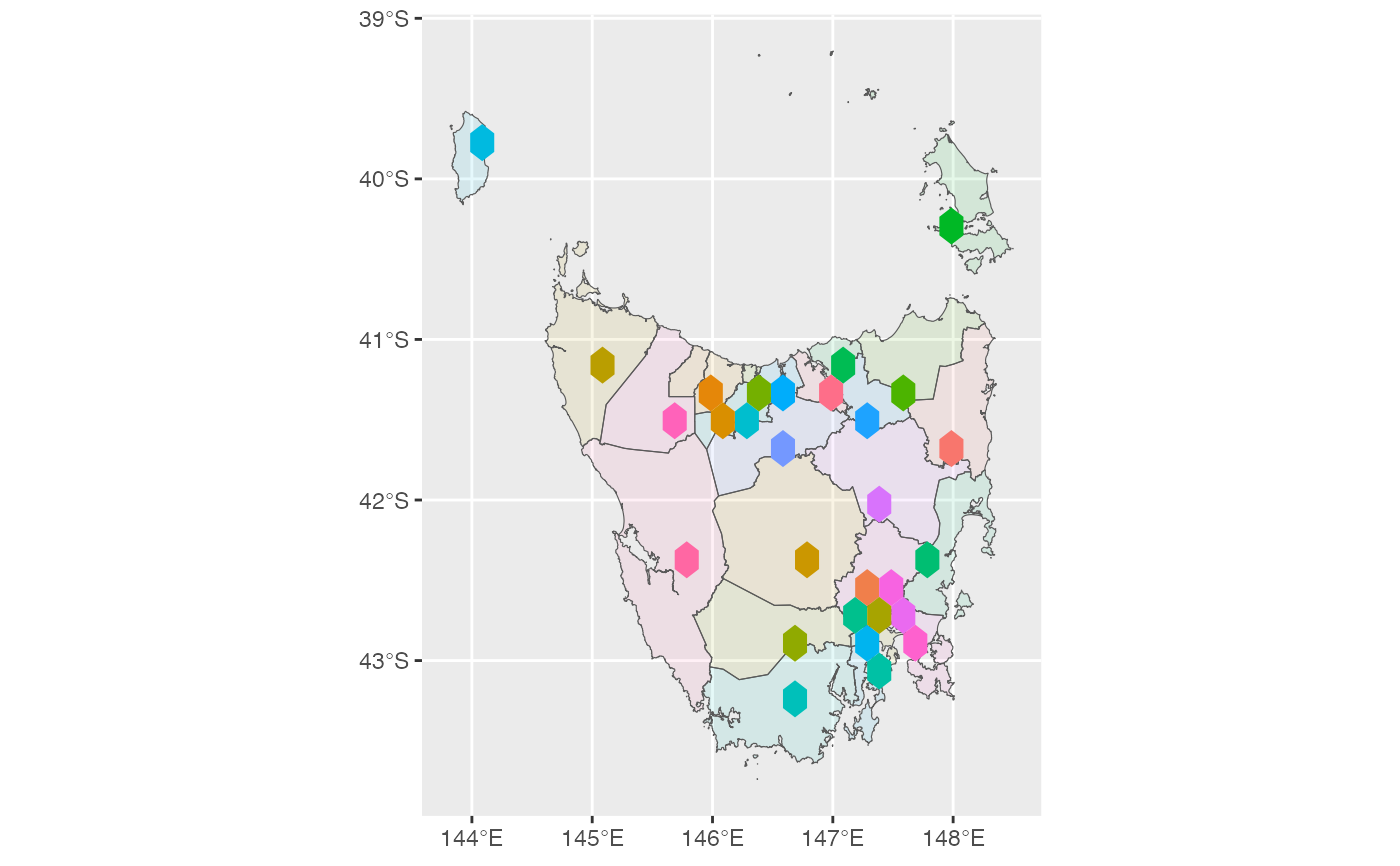geom_sugarbag() provides a convenient way to create tesselated
hexagon maps using the sugarbag algorithm.
geom_sugarbag(
mapping = NULL,
data = NULL,
stat = "sugarbag",
position = "identity",
hex_size = 0.2,
na.rm = FALSE,
...
)Arguments
- mapping
Set of aesthetic mappings created by
aes(). If specified andinherit.aes = TRUE(the default), it is combined with the default mapping at the top level of the plot. You must supplymappingif there is no plot mapping.- data
The data to be displayed in this layer. There are three options:
If
NULL, the default, the data is inherited from the plot data as specified in the call toggplot().A
data.frame, or other object, will override the plot data. All objects will be fortified to produce a data frame. Seefortify()for which variables will be created.A
functionwill be called with a single argument, the plot data. The return value must be adata.frame, and will be used as the layer data. Afunctioncan be created from aformula(e.g.~ head(.x, 10)).- stat
The statistical transformation to use on the data for this layer. When using a
geom_*()function to construct a layer, thestatargument can be used to override the default coupling between geoms and stats. Thestatargument accepts the following:A
Statggproto subclass, for exampleStatCount.A string naming the stat. To give the stat as a string, strip the function name of the
stat_prefix. For example, to usestat_count(), give the stat as"count".For more information and other ways to specify the stat, see the layer stat documentation.
- position
A position adjustment to use on the data for this layer. This can be used in various ways, including to prevent overplotting and improving the display. The
positionargument accepts the following:The result of calling a position function, such as
position_jitter(). This method allows for passing extra arguments to the position.A string naming the position adjustment. To give the position as a string, strip the function name of the
position_prefix. For example, to useposition_jitter(), give the position as"jitter".For more information and other ways to specify the position, see the layer position documentation.
- hex_size
Default is 0.2. Units are degrees, corresponding to the diameter of the hexagons. See
?allocate.- na.rm
If
FALSE, the default, missing values are removed with a warning. IfTRUE, missing values are silently removed.- ...
Other arguments passed on to
layer()'sparamsargument. These arguments broadly fall into one of 4 categories below. Notably, further arguments to thepositionargument, or aesthetics that are required can not be passed through.... Unknown arguments that are not part of the 4 categories below are ignored.Static aesthetics that are not mapped to a scale, but are at a fixed value and apply to the layer as a whole. For example,
colour = "red"orlinewidth = 3. The geom's documentation has an Aesthetics section that lists the available options. The 'required' aesthetics cannot be passed on to theparams. Please note that while passing unmapped aesthetics as vectors is technically possible, the order and required length is not guaranteed to be parallel to the input data.When constructing a layer using a
stat_*()function, the...argument can be used to pass on parameters to thegeompart of the layer. An example of this isstat_density(geom = "area", outline.type = "both"). The geom's documentation lists which parameters it can accept.Inversely, when constructing a layer using a
geom_*()function, the...argument can be used to pass on parameters to thestatpart of the layer. An example of this isgeom_area(stat = "density", adjust = 0.5). The stat's documentation lists which parameters it can accept.The
key_glyphargument oflayer()may also be passed on through.... This can be one of the functions described as key glyphs, to change the display of the layer in the legend.
Details
Create a sugarbag hex map
The sugarbag algorithm creates a hexagon tile map from spatial polygons. It represents each polygon with a hexagon, which is placed close to the polygon's centroid while also maintaining its spatial relationship to a focal point.
If geom_sugarbag() is used to make a map of Australia, the capital cities
will be used as focal points. For non-Australian maps, a single focal point
will be inferred from the data, as the centroid with the smallest total
distance to its three nearest neighbours. To specify focal points manually,
construct your hexagon grid manually – see ?allocate.
See also
allocate, ggplot2::geom_polygon
Examples
# \donttest{
library(ggplot2)
# Map of Tasmanian local govt areas using built-in data
tas_lga %>%
ggplot(aes(fill = lga_name_2016)) +
geom_sf(alpha = 0.1) +
geom_sugarbag(aes(geometry = geometry)) +
theme(legend.position = "none")
#> Error in `[<-.data.frame`(`*tmp*`, names(missing_eval), value = list(colour = ~from_theme(colour %||% NA), hex_size = 0.2, linewidth = 0.2, linetype = 1, alpha = NA)): replacement element 1 has 2 rows, need 31
# Map of SIDS data from North Carolina
if (requireNamespace("sf", quietly = TRUE)) {
nc <- sf::st_read(system.file("shape/nc.shp", package = "sf"), quiet = TRUE)
ggplot(nc,
aes(fill = AREA)) +
geom_sf(alpha = 0.1) +
geom_sugarbag(aes(geometry = geometry))
}
#> Warning: Computation failed in `stat_sugarbag()`.
#> Caused by error in `mutate()`:
#> ℹ In argument: `across(everything(), ~na_if(.x, 0))`.
#> Caused by error in `across()`:
#> ! Can't compute column `sf_id`.
#> Caused by error in `na_if()`:
#> ! Can't convert `y` <double> to match type of `x` <character>.
 # }
# }